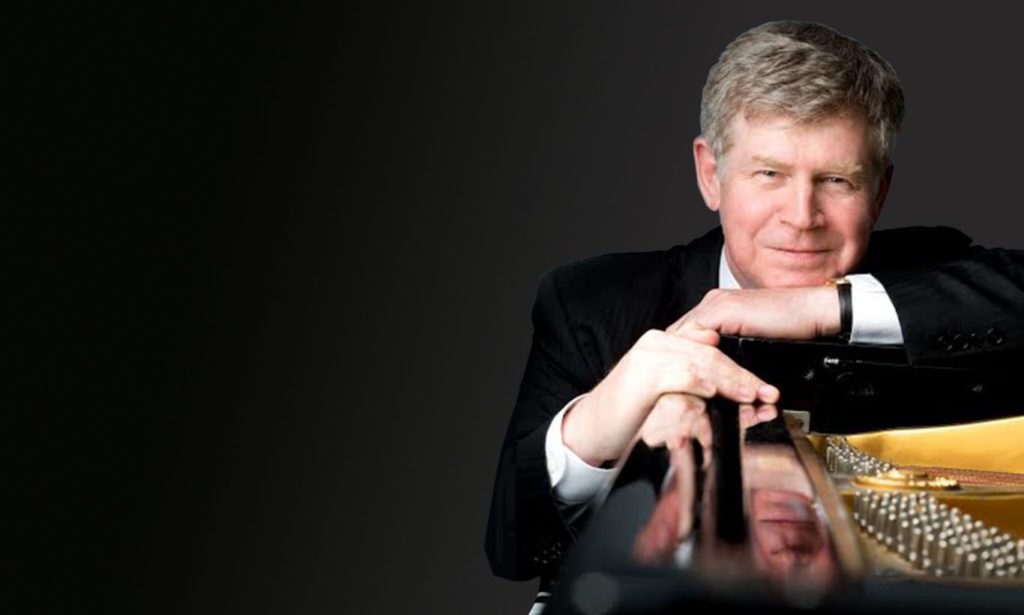Power overwhelms fleeting moments of poetry in Hobson’s latest Schumann installment
Pianist Ian Hobson was back at the Tenri Cultural Institute Friday night for the latest installment of his ongoing multi-season Schumann cycle, a program titled “Love And Nature I.” While general enough to make sense of most music composed during the romantic era, it was probably too amorphous a theme to connect to the works Hobson played, and the style and substance of his performance. Think of it as a way to open the door to Schumann.
Hobson played three works from one of the composer’s most intensely productive periods, including two of his most famous piano pieces, Arabeske, Op. 18; and Novelletten, Op. 21. In between the two was Blumenstück, Op. 19. Hobson divided the large-scale Novelletten in half, with the final four of eight sections played after intermission.
The love and nature metaphor was most clearly about Hobson’s stormy playing. Storminess was inherent to Schumann, part of his tragic psychology and a feature of his compositional style. Even as appropriate as it is, it’s also perhaps the most common romantic cliché. One of the things that makes Schumann perhaps the most emblematic romantic composer lies underneath; how mercurial his music is. Beyond the layers of emotional states and the rapid and extreme shifts in mood, music is constantly in transition, rarely satisfied or comfortable enough to stay in one state for long, with left and right hand tumbling against each other and forward at the same time.
Hobson is clearly inspired by this music, and his natural inclination is passion and intensity; he lights a fire quickly and stokes it to raging almost immediately. That fervor is important in Schumann, but it’s not the only important quality.
Hobson opened the Arabeske with elegance and grace, the right way to set up the sense of nervous anxiety that will seep into the music. The pianist approached that feeling with a nice impetuosity and also control, modulating well between the music’s moods. There was a sense that the dotted rhythms that appear toward the middle were pressing him forward, and his playing gained in weight and intensity, albeit losing some thoughtfulness at the end.
This sense of pressure carried over into Blumenstück. The alternating moods and sensibilities were nicely judged to start, but as the music went along, weight and heat again accumulated in Hobson’s playing. His involvement in the music was clear, and his hands made impressive work at the keyboard, but the elusiveness and complexity of the music was gradually reduced to sheer force.
The first of the Novelletten, “Markiert und kräftig,” opens with a bright fanfare, and Hobson’s chords were proud and sharp-edged. The dynamics and mood change abruptly after this, and Hobson followed the music for a time, but each return of the fanfare pushed him a little louder and a little faster..
There is a quality in Schumann of wandering, the music drifting through episodes of imagination and internalized thinking, then returning in an “aha!” moment to the initial compositional thought, like having someone wander off in thought while they’re talking, then return to the conversation. Hobson delivered plenty of “ahas!” but not enough of the wandering.
His launch into “Äusserst rasch und mit Bravour,” was near-furious, and from that moment the Novelletten never really let up, it was almost all heat, speed, volume, and intensity. Part of this was out of Hobson’s hands; the Tenri space is intimate and also bright and very lively, not really capable of supporting low dynamic levels from the modern piano. There was insufficient acoustic space to contain the range of Schumann’s expression, much less Hobson’s playing, even as the closeness to the pianist was an enticing way to hear the details of the composer’s thinking.
The finale of Novelletten, “Sehr lebhaft,” often played as a stand-alone concert piece, was a microcosm of the performance. Hobson’s power and expressive force were often gripping, and he regained his concentration after some apparent lapses in focus in the previous section, but the music glides into quieter, more gently ruminative stretches that are important. In each, Hobson started with a tone that contrasted starkly with the dynamics and mood that came before, but only a short time later the power came flowing back, like lava, and swamped the delicacy one was enjoying.
Ian Hobson’s Schumann cycle continues 7:30 p.m., April 21, at Tenri Cultural Institute. eventbrite.com



